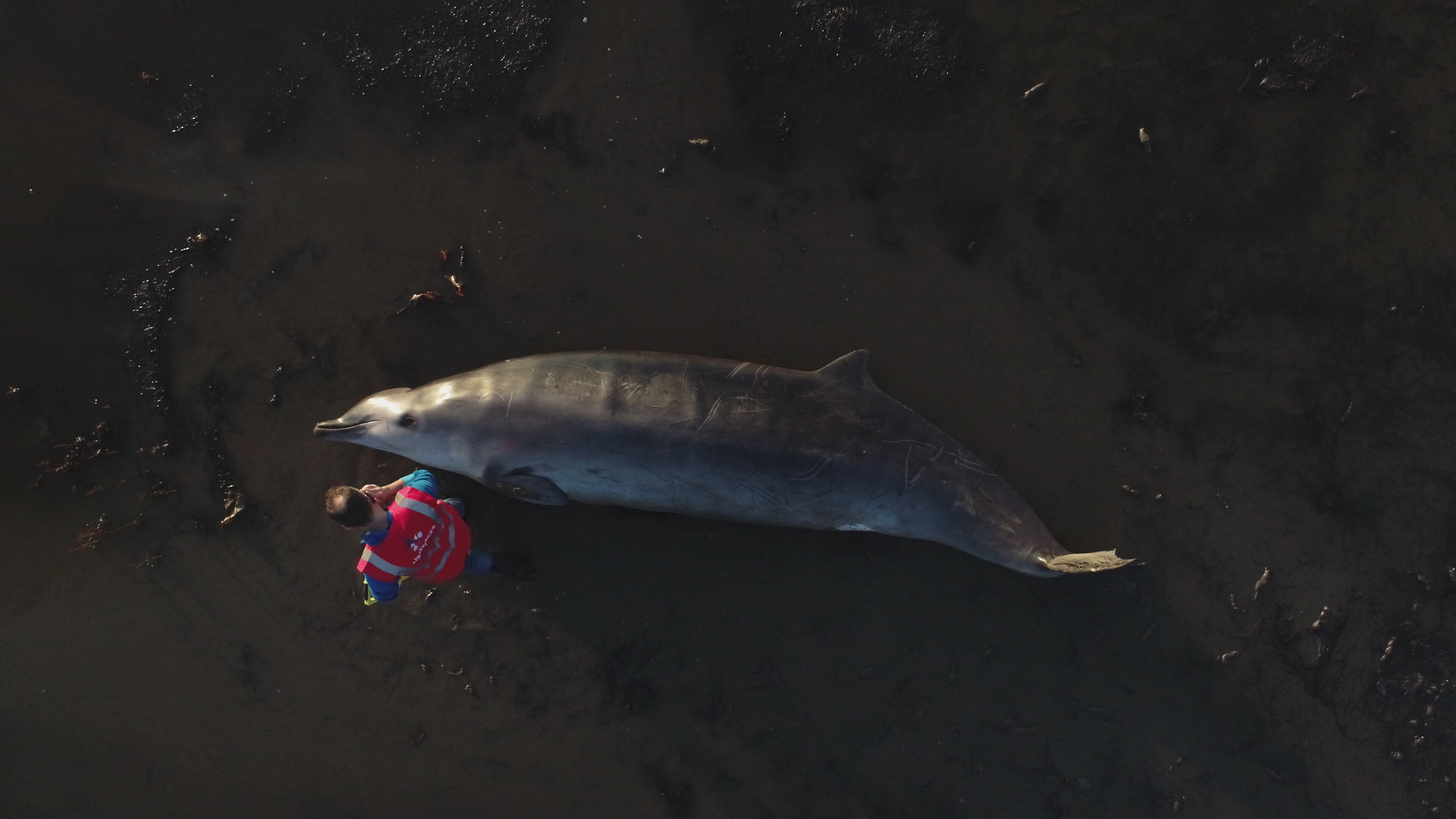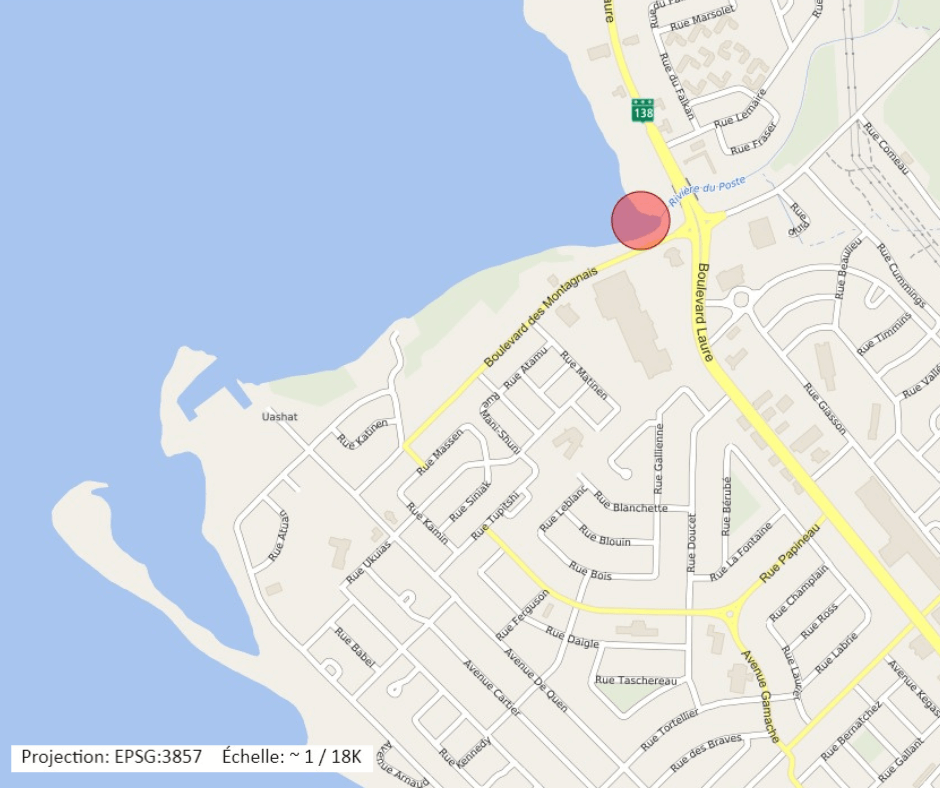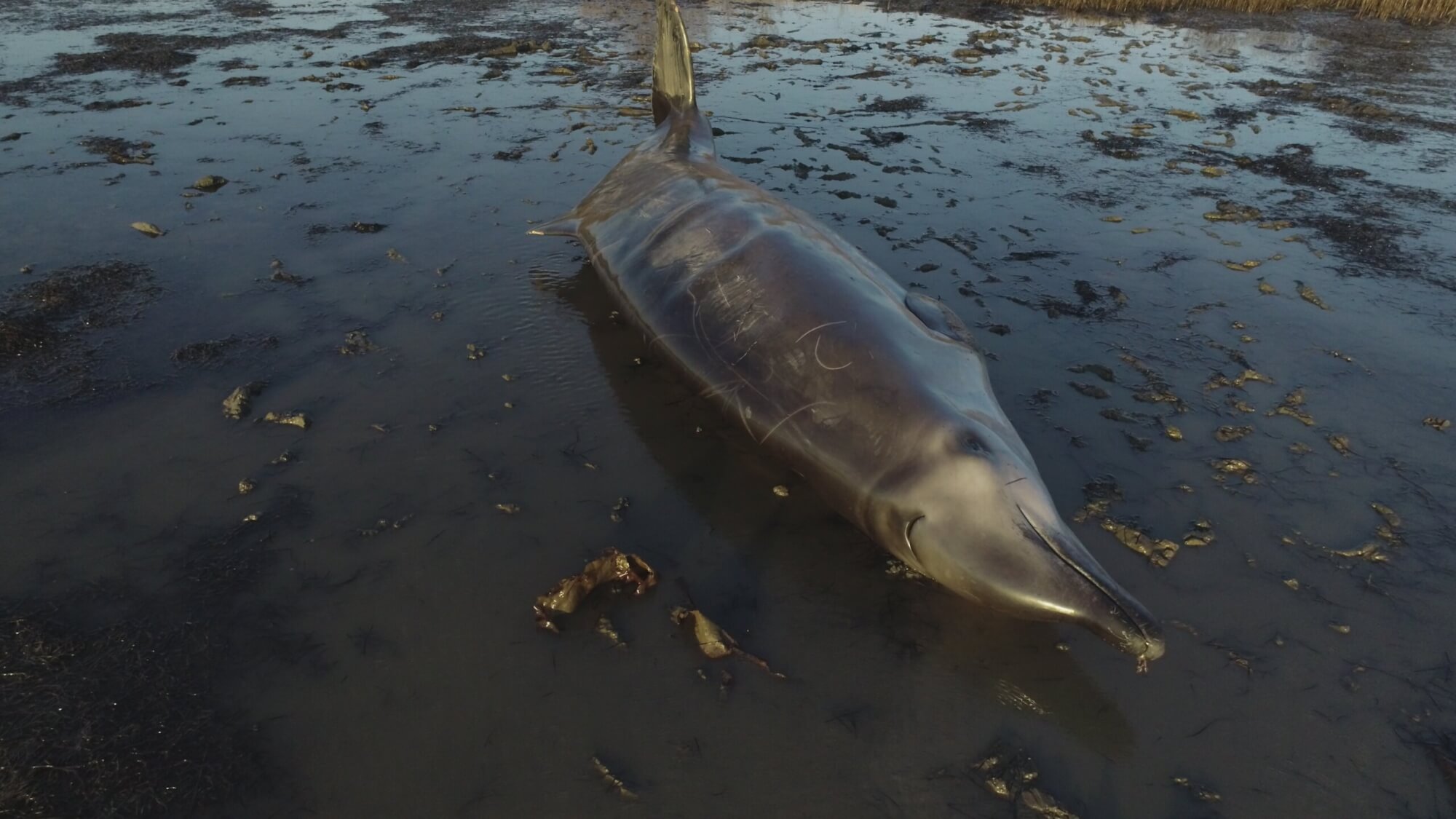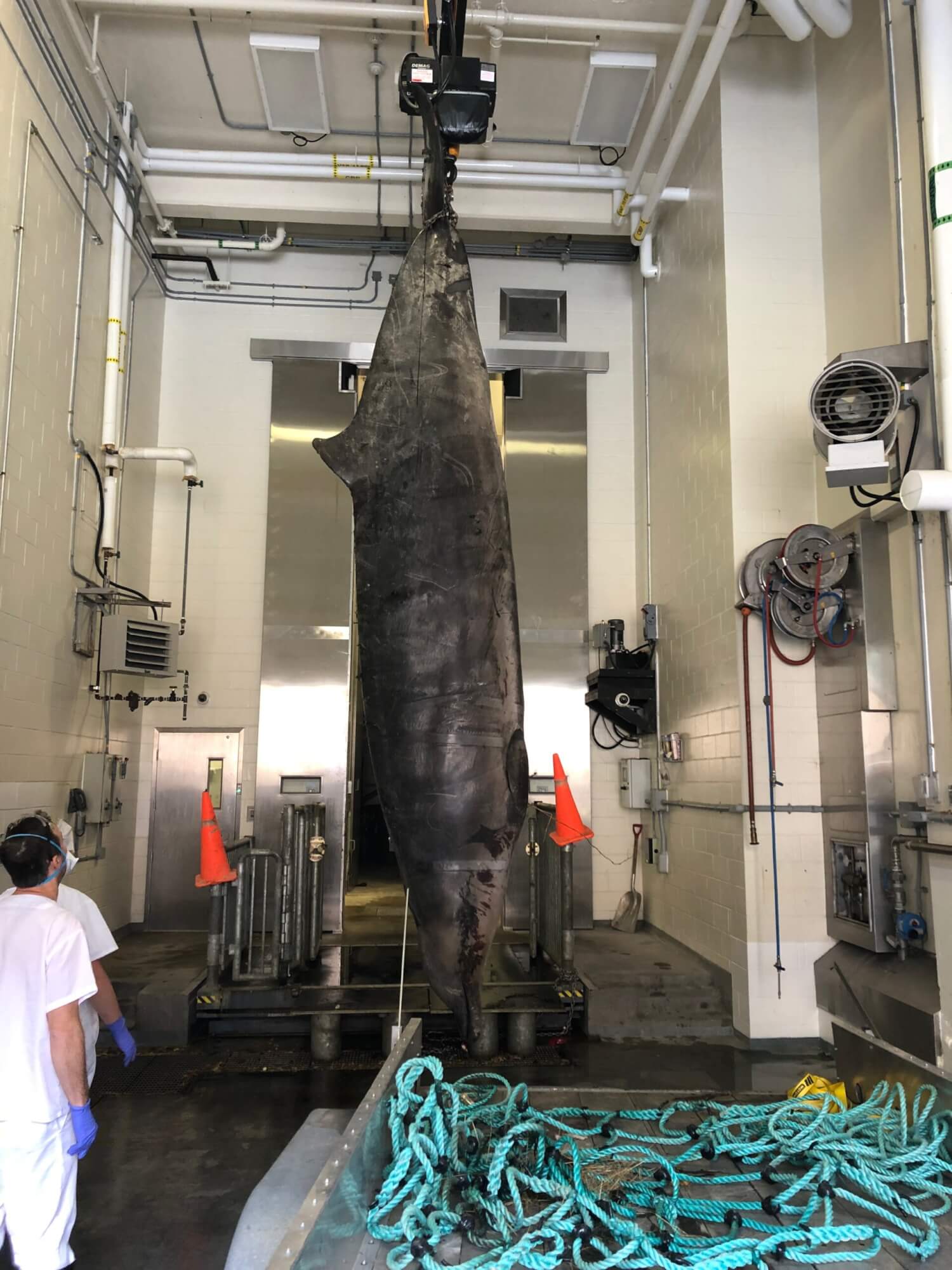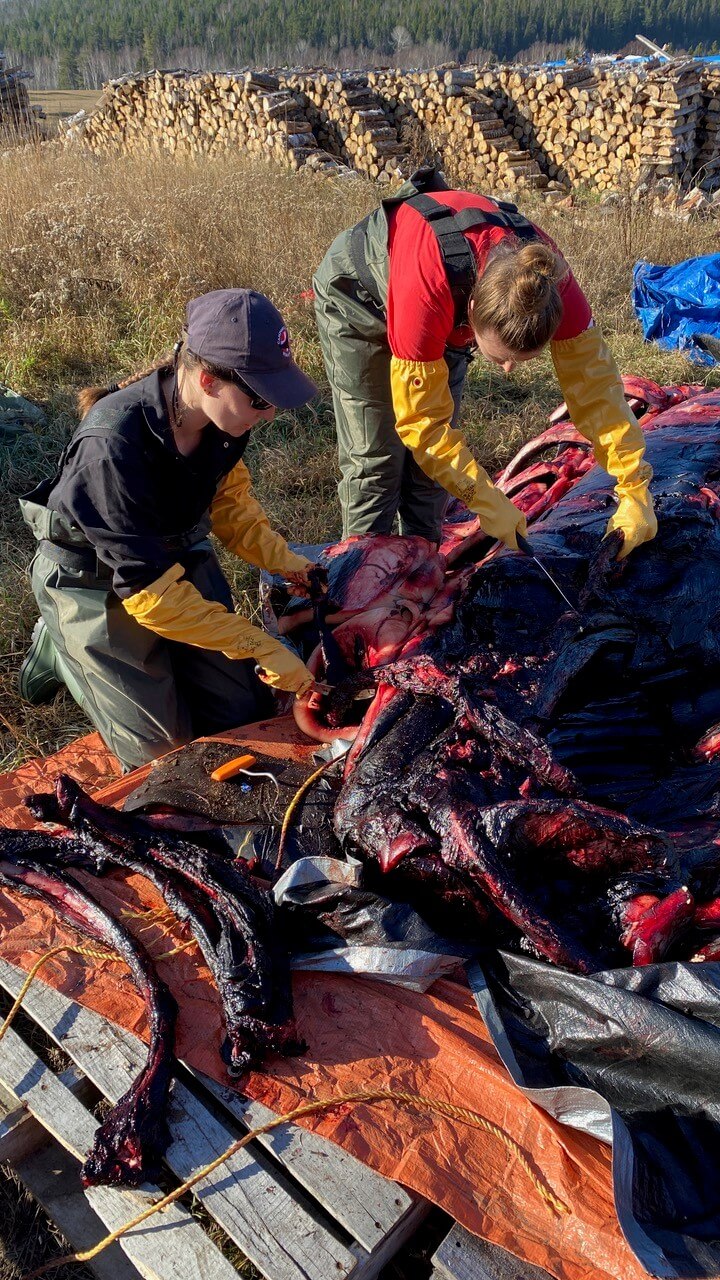Last October 23, a True’s beaked whale beached itself and died in the Bay of Sept-Îles. The causes of this animal’s stranding are not yet known, but closer examination of the carcass will certainly shed some light on this cetacean! Beaked whales spend most of their time in the open sea and are regular visitors to the ocean abyss: the Cuvier’s beaked whale, for example, can dive to depths of nearly 3,000 m below the surface!
An unfortunate ending
At 1:30 in the afternoon on Sunday, October 23, the first witness calls the Quebec Marine Mammal Emergency Response Network (QMMERN). The person has just observed a whale struggling in the Bay of Sept-Îles. The observer describes the animal as being black in colour and having a small dorsal fin, and notes that it seemed to be stuck at the bottom of the water as it waved its tail fin.
A few minutes later, Sûreté du Québec phones the QMMERN to share the testimony of one observer, according to whom a citizen allegedly tried to push the whale out to sea.
As a crowd begins to form around the animal and along the shore, the QMMERN, as coordinator of the response effort, mobilizes field responders trained to intervene in this type of situation. The QMMERN reaches out to its partners and volunteers to travel to the site to validate the situation and relay the information to the Network’s headquarters. Anik Boileau of the Sept-Îles Education and Research Centre (CERSI) identifies the individual as a beaked whale (Ziphiidae), though is unable to confirm the exact species in the field. Indeed, this family comprises several species, including Sowerby’s, Baird’s and Cuvier’s beaked whales, as well as others. Identifying them is a challenge. A number of these species look very similar, but it is generally rare to see them due to their way of life. The location of the teeth can be a clue to distinguishing one species from another.
At the time of the stranding, a few lesions on the animal’s pectoral fins as well as a scar on its dorsal fin were noted. At first glance, the whale’s physical condition was disturbing: it appeared emaciated and lethargic before it died. Preliminary observations as well as numerous photos and videos were then transmitted to Dr. Stéphane Lair, veterinarian and director of the Centre québécois sur la santé des animaux sauvages (Quebec wildlife health centre, CQSAS). Dr. Lair deemed that this animal’s chances of survival were slim and that nothing should be done to postpone its death.
Unfortunately, manoeuvres were attempted to support or push the animal back into the sea without waiting for the green light or recommendations from the veterinarian. The animal finally died a few minutes later, at 3:38 p.m.
Keeping one’s distance
It is unlawful for a citizen to approach a marine mammal or attempt to push it back into the water. A poorly executed intervention can have serious consequences for the animal and/or the spontaneous good Samaritan. It is important to let trained professionals manage this type of event. Responders must obtain a permit from the Department of Fisheries and Oceans (DFO) to handle or intervene with a marine mammal.
Before making any attempt to handle the animal, CQSAS veterinarians are consulted. These professionals complete an assessment of the animal’s state of health, its condition and its chances of survival. Depending on the diagnosis, the responders’ safety and the animal’s status under the Species at Risk Act (SARA), the QMMERN fleshes out an appropriate action plan.
Strandings are very emotional, both for the general public and for the authorized and trained responders who believe they are acting in the animal’s best interest, though one must not forget that we are dealing with wild animals! The latter are not only unpredictable, but can also transmit diseases. In the absence of sound veterinary advice, any attempt to release or move a vulnerable animal may cause it additional stress and/or aggravate its condition. If you observe a dead or struggling marine mammal in Quebec, the procedure to follow is simple: rather than taking matters into your own hands, call the QMMERN at 1-877-722-5346.
Beaked whales: a poorly known family
Strandings in this whale family are few and far between, making it difficult to ascertain the causes of such events. The carcass of the True’s beaked whale found in Sept-Îles is of interest for researchers, as very little data exist for this seldom-observed species. If scientists could better explain what causes these cetacean strandings in the first place, it would be easier to adopt adequate conservation strategies.
In eastern Canada, five species of beaked whales have been documented: northern bottlenose whale, Sowerby’s beaked whale, Blainville’s beaked whale , Cuvier’s beaked whale and True’s beaked whale. Worldwide, over 20 species of beaked whales are known. New species are still being discovered, most recently in 2019 and 2020! However, the ranges of beaked whales are poorly documented and not well understood. These cetaceans live far from the coast, which is part of the reason they rarely run aground. They are accustomed to diving to great depths to feed on squid, octopus and fish.
It is difficult to identify beaked whale species from aerial photos or those taken aboard ships. Investigations of sightings are complex, as these cetaceans do not spend much time at the surface. As these odontocetes communicate with each other with clicks, hydrophones can be used to track their presence. The beaked whale family is poorly known, though a number of studies have been conducted on this group in recent years.
A carcass is worth a thousand words
The whale’s carcass was recovered in the Bay of Sept-Îles on October 25. It was subsequently transported to the Faculty of Veterinary Medicine of Saint-Hyacinthe, where Dr. Stéphane Lair performed a necropsy on the animal on October 26. In this procedure, muscle, skin and tooth samples are analyzed in order to identify the potential presence of contaminants, the quality of food and the presence of injuries – particularly those related to noise pollution and human activities.
The individual in question is a True’s beaked whale (Mesoplodon mirus). This species shows a characteristic pale white band across its melon, a fatty mass located in the head of toothed whales. The shape of the mouth as well as the presence of teeth protruding from the tip of the rostrum also lead to the conclusion that this is a True’s beaked whale. V-shaped grooves under the jaw are used by the animal to suck up its prey. The animal’s genital slit revealed the presence of a male sex organ. This individual’s two canines measured about 1 cm each; only in males do the teeth stick out above the gums. One of these teeth was sent to DFO’s Maurice Lamontagne Institute to determine the whale’s age. The specimen measured 4.87 m, indicating that it was an adult; males of this species reach sexual maturity at around 4.8 m.
Dr. Lair explains, “Although some of the photos taken at the site of the stranding suggested that this specimen was in suboptimal nutritional condition, this initial impression was not confirmed during the necropsy. Indeed, the animal actually appeared to us to be in an acceptable nutritional state. […] Note that this whale’s body is normally very “flat” in shape, which can give the impression that it is underweight.” Its body mass of 960 kg is within the norm for this species, however.
Dr. Lair concludes that “The only significant finding observed in this animal upon macroscopic examination is the presence of a plastic foreign body in the main stomach. Although this foreign object may have adversely affected the animal’s digestive dynamics, we do not believe that it was responsible for the stranding. At the current time, what caused this True’s beaked whale to run aground remains unknown.” Algae was also found in the first gastric compartment, which is abnormal. Histopathological analyzes will be carried out for further insight on the potential causes of mortality.


